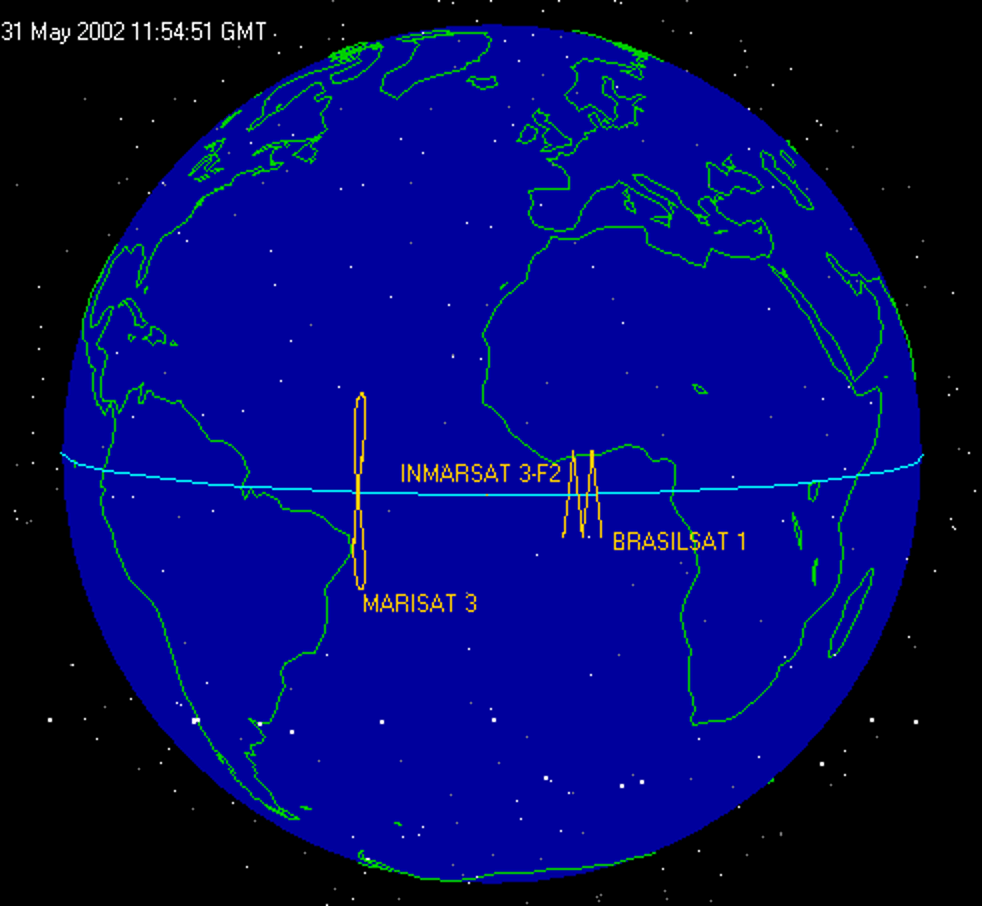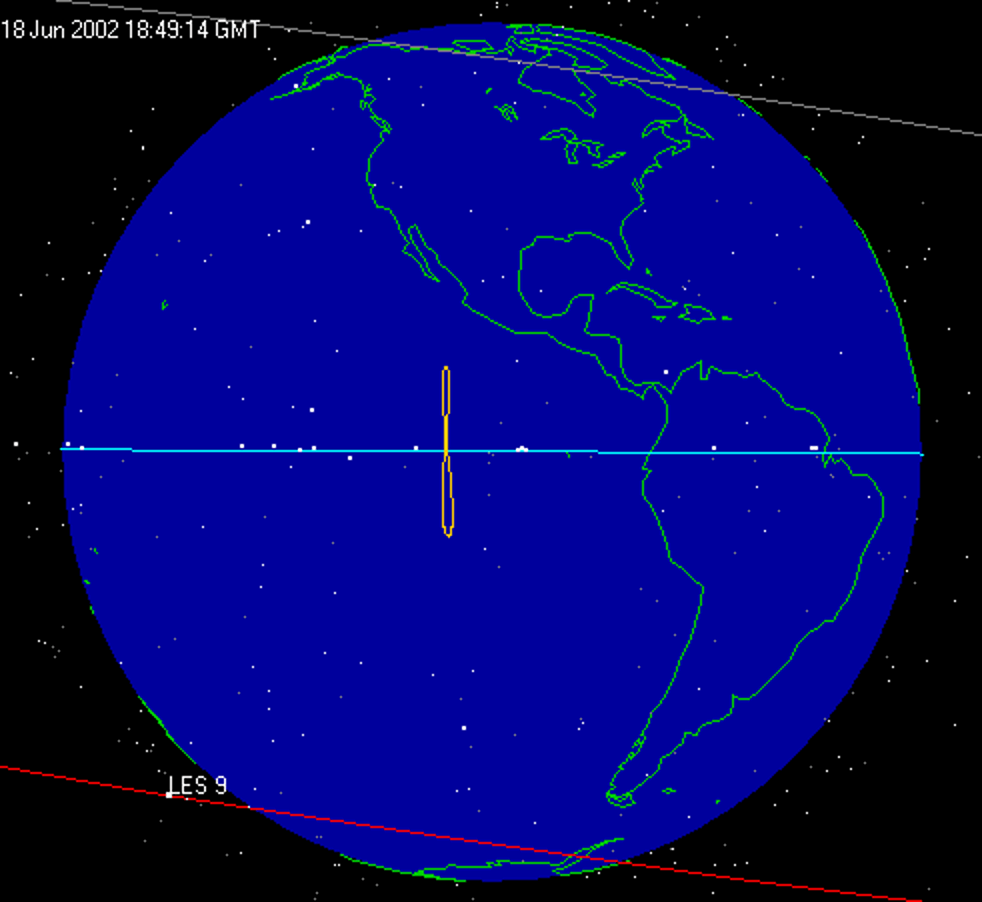


Science and Faith
Science and Faith
Catholic Outlook
Catholic Outlook

Catholic Outlook
Science and Faith
Science and Faith
__________ Recent Additions __________
Catholic Outlook
Catholic Outlook
Dialogue on Looping and
Zig-Zagging Satellites
(Part 5)
How the the apparent motion of geosynchronous
satellites proves that the earth rotates
Gary Hoge
__________ About this Dialogue __________
A continuation of my dialogue with Catholic geocentrist Bob Sungenis. My words are in black, and Bob’s are in blue.
I don’t see how you can explain this motion in a geocentric world. I say these satellites are simply orbiting in synch with the rotation of the earth. But you have to say that they’re actually “levitating” above the earth. When I asked you what causes these multi-ton satellites to “levitate” above the surface of the earth, you pointed to the Lense-Thirring effect. But I don’t think that’s an adequate answer, for several reasons:
First, the Lense-Thirring effect is part and parcel of Einstein’s General Relativity theory, which you claim is “an absolute farce.” According to a paper called “General Relativistic Frame Dragging” at the Duke University Physics Department website, “Einstein’s theory of general relativity has been highly successful at explaining how matter and light behave in strong gravitational fields, and has been successfully tested using a wide variety of astrophysical observations. The frame-dragging effect was first derived using general relativity by Austrian physicists Joseph Lense and Hans Thirring in 1918.” If the Lense-Thirring effect is a relativistic effect derived from Einstein’s Relativity equations then it’s off-limits to you as long as you continue to claim that Relativity is “an absolute farce.” You can’t depend on Einstein’s theories only when it’s convenient for you to do so, and reject them otherwise.
Second, frame-dragging can’t account for the motion of the satellites I showed you. According to the paper from Duke:
General relativity predicts that massive rotating objects should drag space-time around themselves as they rotate,” said [Dr. Erricos] Pavlis. “Frame dragging is like what happens if a bowling ball spins in a thick fluid such as molasses. As the ball spins, it pulls the molasses around itself. Anything stuck in the molasses will also move around the ball. Similarly, as the Earth rotates, it pulls space-time in its vicinity around itself. This will shift the orbits of satellites near the Earth.
In your geocentric world, you of course flip this around and claim that the earth is stationary and that a massive, rotating shell of stars drags things along with it. But the stars rotate toward the west, and although some of the geosynchronous satellites do move toward the west (e.g., Brasilsat 1, Express 1), others are stationary (e.g., Echostar1, Galaxy 5), and still others move toward the east (e.g., Intelsat 604, Raduga 31), which is against the force that supposedly holds them up. If the stars did exert a frame-dragging effect on these satellites, the effect would be uniform. In fact, you yourself said, ”[W]e would expect them to go toward one direction, since the rotation of stars around them is always the same.” I guess you didn’t know that they don’t all move in the same direction. Therefore, your explanation can’t account for the very different motion we see from these satellites.
Third, the Lense-Thirring effect apparently isn’t all that strong. Again, according to the paper from Duke: “We found that the plane of the orbits of LAGEOS I and II were shifted about six feet (two meters) per year in the direction of the Earth’s rotation.” That’s six feet per year. I don’t see how such a subtle effect could cause the extreme range of motion we see every day from the geosynchronous satellites.
Fourth, if the Lense-Thirring effect exerts a force strong enough to spin hurricanes and levitate four-ton satellites, why doesn’t it induce the earth to rotate toward the west?
The bottom line is that even if it weren’t hypocritical of you to rely on General Relativity to explain why geosynchronous satellites supposedly levitate, you still haven’t shown or explained how this effect can account for the actual motion of the actual satellites I’ve entered into evidence.
Next, when I asked you what force causes a satellite like Marisat 3 to move in a figure-eight while Inmarsat 3-F2 holds still and Brasilsat 1 moves in a westward zigzag, you claimed that these satellites must be oscillating at an equilibrium point between the earth and the stars in a way that’s analogous to an object levitating in a magnetic field. But there are several problems with this explanation.
First, you haven’t shown that the earth and the stars exert a force on a satellite that is analogous to a magnetic force and that would cause it to levitate. Magnetic levitation only works if the magnet is pushing the levitated object away from it. But you deny that the earth repels satellites. Therefore, your magnet analogy isn’t analogous to the situation we’re considering.
Second, if the earth and the stars are both pulling on the geosynchronous satellites, it would be theoretically possible to place a satellite at the point of equilibrium between those two forces, but that equilibrium point would be extremely unstable. After a few days the satellite would drift away from the equilibrium position. It would be possible, of course, to keep it in position using station-keeping maneuvers (which is how NASA keeps the Solar and Heliospheric Observatory Satellite (SOHO) in position at the unstable Lagrange point L1 between the earth and the sun. But as soon as the satellite ran out of fuel, it would quickly drift away from the equilibrium position and accelerate toward either the earth or the stars. But Gorizont 20, for example, has been out of service since February, 1999, and yet it still “levitates” above the earth. Also, the Cosmos 2345 satellite moves toward and away from the earth 1,378 km every day. Obviously, that’s not possible if the satellite is supposedly levitating in an equilibrium position between the earth and the stars.
Third, some of the geosynchronous satellites oscillate considerable distances in the north-south direction relative to the earth. LES 9, for example, moves 34,720 km every day in a giant figure-eight:
Unfortunately, this discussion has gotten so bogged-down in minutia, it’s hard to remember what it was supposed to be about. So, I’m going to try to clarify what’s at issue here. I offered as evidence of the earth’s rotation the fact that geosynchronous satellites appear to hover over the surface of the earth. Some of them also move around in figure-eight, oval, zigzag, and other regular patterns:


You claim that a satellite like this is being drawn toward the equator, and therefore, it oscillates back-and-forth relative to the equator. But in real life, satellites are drawn away from the equator, and they have to use their thrusters from time to time to maintain an equatorial orbit. According to “Basics of the Geostationary Orbit,” by Dr. T.S. Kelso:
Since the geostationary orbital plane is not coincident with the plane of the earth’s orbit (the ecliptic) or that of the moon’s orbit, the gravitational attraction of the sun and the moon act to pull the geostationary satellites out of their equatorial orbit, gradually increasing each satellite’s orbital inclination. . . . To counteract these perturbations, sufficient fuel is loaded into all geostationary satellites to periodically correct any changes over the planned lifetime of the satellite. These periodic corrections are known as stationkeeping. North-south stationkeeping corrects the slowly increasing inclination back to zero and east-west stationkeeping keeps the satellite at its assigned position within the geostationary belt. These maneuvers are planned to maintain the geostationary satellite within a small distance of its ideal location (both north-south and east-west). This tolerance is normally designed to ensure the satellite remains within the ground antenna beamwidth without tracking. Once the satellite has exhausted its fuel, its inclination will begin to grow and it will begin to drift in longitude and may present a threat to other geostationary satellites.
Obviously, it’s not possible for satellites like LES 9 to be drawn toward the equator so strongly that they oscillate back-and-forth across it if at the same time other satellites are being pushed away from the equator.
An oscillating GSS against a stationary earth DOES explain the various patterns. That is a fact. Gary chooses not to accept that model because he can’t accept that the forces of the stars and the earth can create a point at which the GSS can hover.
No, I don’t. And I won’t unless and until you can explain how these forces can account for all of the satellite motion I’ve entered into evidence. So far, you haven’t even come close to doing so. Every time you try to account for one fact, six others get away from you.
Your “elaborate figure” doesn’t prove anything for you. If you have a degree in Engineering then you should know that the apparent motion of an object can be explained in one of two ways: either the object is actually moving or the background behind or in front of it is moving. You can’t tell which is correct unless you have some way of verifying it.
Right. If I’m looking out the window of my car, I can’t tell whether I’m moving or that house over there is. Except that I know houses don’t move. So it must be me. Likewise, I know that unpowered satellites can’t move in figure-eight and zigzag patterns. So I know the earth on which I’m standing must be moving, too.
Previous:
His understanding about opposing gravitational and magnetic fields is wrong.
Not if those forces are pulling, which they would be if they were analogous to gravitational attraction. If they’re pushing against each other then, yes, you could suspend something between them. Of course, then you’d no longer have a system that was analogous to the gravitational pull from the earth and the stars.
You’re stuck on the wrong track, Gary. Pulling or pushing is not the issue.
Sure it is. If the earth and the stars are both pulling on the satellite, the equilibrium point between those two forces would be extremely precarious, and balancing a satellite at that point would be like trying to balance a pencil on its point. But if the earth and the stars are pushing on the satellite, then the equilibrium position would be stable, but then you wouldn’t be able to explain why lower-flying satellites aren’t pushed up to the equilibrium point. So pulling or pushing makes all the difference in the world.
Equilibrium between the stars and the earth is the issue.
But what kind of equilibrium? That depends entirely on whether we’re talking about pulling or pushing forces.
Moreover, notice that Gary does not try to answer my argument by showing that a gravitational field from the stars is impossible to happen, rather, he resorts to calling them “imaginary forces.”
I didn’t say that a gravitational field from the stars was impossible, I just pointed out that even if such a thing existed it couldn’t account for all the facts, as I explained above.
[At this point, Mr. Sungenis broke off the discussion, citing the need to answer other people who had “more pertinent material” to offer.]
Part 1, Part 2, Part 3, Part 4, Part 5
Copyright © 2024 Catholicoutlook.me
MENU